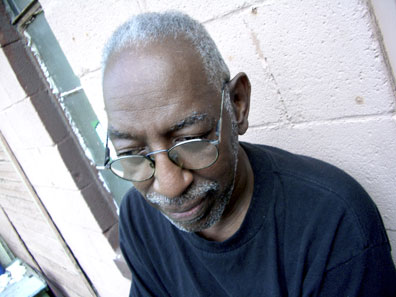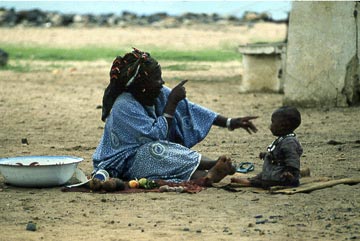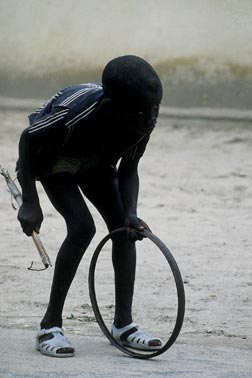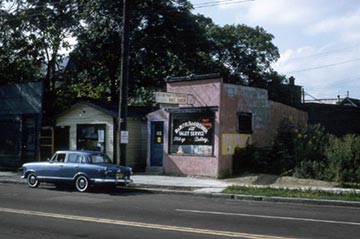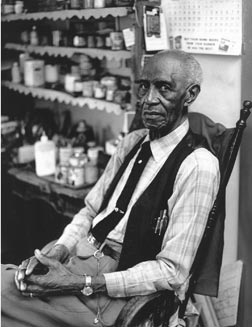
Columbus, Ohio USA
Return to Homepage www.shortnorth.com
Columbus Caught on Film
Photographer Kojo Kamau's new book shows us how the Cap city used to be
By Jennifer Hambrick
August 2006Return to Features Index
Kojo Kamau Photo / © Rick Borgia Veteran photographer Kojo Kamau remembers many things about Columbus. He remembers when Mt. Vernon Avenue was a thriving business district of the African-American community. He remembers when downtown Columbus was full of plush movie houses, and when the grand hotels lining Capitol Square gave businessmen, politicians and celebrities shelter on their visits through town. He remembers when streetcars criss-crossed the Cap city and when men and women put on their best suits and their nicest hats to take a trolley downtown and out into the world.
Kamau’s most recent project, Columbus Remembered, unites the Columbus of the past and present in an anthology of photographs of Ohio’s capital from the years 1960 and 2006. As the saying goes, the more things change, the more they stay the same, and the 28 images of Columbus in Kamau’s book confirm the truth of this adage. Some depict buildings virtually unaltered by time, while others show a vastly different Columbus from the city that nurtured Kamau into one of its best-known black artists.A Black and White World
Kamau never could have known that the five dollars he spent as a kid for a tiny Kodak box camera in the days before 35-millimeter film was his first real investment. He remembers running around his family’s east-side neighborhood with his Kodak, snapping pictures just for fun, and shooting alongside his Boy Scouts master. Kamau says none of those photos turned out very well, but at the time that didn’t matter.
Also at that time, during the 1950s, the business district along Mt. Vernon Avenue was the economic hub of Columbus’s African-American community and was a microcosm of the world beyond. There were restaurants and garment shops, furniture stores and a collection of nightclubs where the jazz legends of the day came to play.
Kamau’s strolls down Mt. Vernon Avenue often took him by the studio of photographer George Pierce, a black photographer who, Kamau says, probably never knew he was a role model.
“I used to see him shooting pictures with his professional camera, which I didn’t have at the time,” Kamau said. “I would just see him out different places on the street, and I’d see his photographs in the African-American newspaper at the time. He was an influence in my deciding to go into photography, because it was something that I really liked to do and I saw that there was someone making a living at it, and I felt that maybe I could do the same thing.”
Kamau took a photography class at Columbus’s East High School, and on graduating in 1959 enrolled at Columbus Art School (now the Columbus College of Art and Design). He took classes at night, working by day as a stock clerk and salesman at Mogol’s Menswear on High Street, between Broad and Long Streets. He remembers spending exactly $40 of his earnings from Mogol’s on a semi-professional camera that saw him through his only year of professional training in photography.
Kamau had spoken with an Air Force recruiter who told him he could work any type of job he wanted – even as a photographer – if he enlisted. Planning to continue his hands-on education in photography in the military, Kamau enlisted in the Air Force in the fall of 1960.
He made another whirlwind photography tour of Columbus before leaving for Myrtle Beach Air Force Base in October. The photographs of now-defunct establishments, like the Neil House Hotel, Lazarus department store, Union Station and the old Chamber of Commerce building, that appear in Columbus Remembered come from Kamau’s last jaunts through town before leaving for South Carolina.
For Kamau, Myrtle Beach was anything but the paradise many make it out to be today. On the base he managed to get experience taking pictures for the base newspaper, which he also edited. The civilian world was another story, where even segregated beaches dictated where he could and couldn’t swim during his days off.
“The base was fine,” Kamau said. “You just couldn’t go anyplace in town. It was segregated. You couldn’t even go in the ocean. It was right outside the base and you had to go 20 miles down the road to get in the ocean.”
Kamau returned to Columbus after four years in the service and got a tip from his old Boy Scouts master about a job opening for a photographer in the medical illustration department of Ohio State University’s School of Allied Medical Professions.
He got that position, which he held until his retirement in 1994. The job also sustained Kamau’s sideline careers as a documentary photographer and gallery owner, for which he is best known in Columbus today.
Mother & Child by © Kojo Kamau Making the Case for Africa
Even if Kamau’s professional opportunities were not limited by segregation, his work in a predominantly white field has brought him face to face with others’ misperceptions of Africa and the African-American community.
“There’s a negative connotation to Africa,” Kamau said. “Most people think of trees and jungles and animals, or they think of hunger. It’s not just all villages just out in the middle of the jungle. When I travel to Africa, I try to bring back what I consider are positive images of Africa: people working, families together, the fact that everyone does not live in a straw house, that there are streets and freeways and skyscrapers like everywhere else.”
He also says media depictions of angry African-American leaders do not represent how most black Americans really live.
“In the ’60s and ’70s, whenever you would see one of our leaders in the newspaper, they always look angry and they had their mouths open and they were always just looking like mad people. If you shoot enough pictures you’re always going to get someone in a position that shows that, but I always try to show the natural, human side of people, the way they are 90 percent of the time.”
Kamau’s career as a documentary photographer was born from a desire to change these misperceptions.
“There was a lack of positive documentation of our lifestyle, so I wanted to make a contribution to rectify that,” Kamau said. “Of course, there may be about a half-dozen black people of note that we are taught about in school: Sojourner Truth and Harriet Tubman and Frederick Douglass during that era. There’s the Civil War period and just before and right after, but after that it’s like nothing really much happened in our community except for Martin Luther King. And then you jump from there up to the 1960s and then he’s gone. I do not believe it’s up to others to bring out the positive things in our culture. It’s up to us as a people to do what we can.”
In “African-American Visionaries,” a series of candid photographs of leaders of the African-American community, Kamau encapsulates the positive contributions black Americans made to 20th-century American culture while also capturing the essence of each individual, untainted by the media spotlight. The noteworthy people represented in the series include the likes of legendary woodcarver Elijah Pierce and jazz musician Miles Davis. A 1974 image shows Jesse Jackson in a subdued mid-speech moment. A candid photograph of Maya Angelou captures the poet in all her refined dignity, bearing an expression that conveys at once struggle, discernment and determination.
Boy with Hoop by © Kojo Kamau The same honesty comes through Kamau’s images of Africa, which he visited for the first time in 1978. Prints from his twelve trips to the continent capture all aspects of the human condition and exude the natural beauty of the landscape. “Mother and Child” shows a Senegalese woman talking in broad gestures to her tiny child, who sits captivated at her feet. The many different expressions on the faces of the women in “Bread For Sale” convey the breadth of humanity that emerges when come together in the bustle of an Ivory Coast market.
Shortly before going to Africa, Kamau and his late wife, actress, poet, playwright and broadcaster Mary Ann Williams, opened Kojo Photo Art Studio, a studio/gallery to promote Kamau’s work and the work of other up-and-coming artists. In 1979, Kamau and Williams also established Art for Community Expression (ACE), a non-profit venture to help African-American artists expose their work to mainstream audiences. By 1986, ACE had its own gallery space at 772 N. High St. in the Short North and had become a granting agency, raising and disbursing funds to enable black artists to travel to Africa.
Noted artist Aminah Robinson was one of three Columbus artists whose first travels were funded by ACE. Larry Collins, formerly on the faculty of the Columbus College of Art and Design and Antioch College, also traveled to Africa under the auspices of ACE, as did Charles Dillard, who now teaches art in the Dayton Public School system.
The highpoint of Kamau’s output documenting African-Americans may well be expressed in his images of legendary barber and woodcutter Elijah Pierce. These images exude the warmth of both Kamau’s sensitive eye for the truth of his subject, and the warmth of his ten-year, father-son-like relationship with Pierce.
“I always said, when I grow up I want to be like Mr. Pierce,” Kamau said. “He was a gentleman. He was very tall and slim, and I think we may have hit it off because I was not quite as tall as he was, but I was slim and I think I might have reminded him of himself when he was younger. I would go to the barbershop and talk with Mr. Pierce and shoot some photographs. It was always an honor for me for him to come to my openings. I had art reception openings on Sunday afternoons and he and his wife would always come to my openings and they supported ACE.”
Kamau has taken an equally candid yet gentle approach to depicting other aspects of African-American life. Perhaps the most intriguing thing about Columbus Remembered is the understatement with which he demonstrates how areas once in primarily black parts of town fared between 1960 and 2006. Facing his image of the bustling Mt. Vernon Avenue of 1960 is today’s Mt. Vernon Avenue boasting not crowds and specialty shops but a strip mall and empty sidewalks. His image of the Lincoln Theatre, originally built in the 1920s as a meeting place for the African-American Grand United Order of Odd Fellows, in 1960 shows a marquee trumpeting feature film titles and people gathering for a show, while in 2006 the same marquee baldly announces ballroom space for rent.
Long Street Hat Shop by © Kojo Kamau The Way Things Were
What strikes the viewer most about images like the ones of Mt Vernon Avenue and the Lincoln Theatre in 1960 is their sense of longing for the past. Kamau says he feels a sense of nostalgia for this part Columbus’s history, and considers history in general an important part of his aesthetic as a documentary photographer.
In another pair of images in Columbus Remembered, Kamau contrasts the intersection of Broad and High Streets in 1906 and 2006. The 1960 photo could have been shot in Manhattan, so busy is it with a jumble of large neon signs announcing restaurants, jewelers and department stores, pedestrians packing the crosswalks and a canopy of power lines spanning the narrow chasm between the rows of buildings lining High Street. By contrast, the absence of overhead power lines, the inlaid brick crosswalks and the presence of – of all things – a Starbuck’s Coffee give today’s Broad and High a gentrified, yet generic and almost antiseptic feel. It looks less like a bustling downtown and more like what it is: a formerly bustling downtown trying to lure people back to it by seeming urbane instead of urban.
Kamau remembers the downtown Columbus of 1960 as the lively destination point his photgraph suggests it was.
“It was more of a downtown then,” Kamau said. “I lived on the east side of town, and so going downtown was like taking a trip. You got all cleaned up and dressed up to go downtown. You wanted to look your best to go downtown because you knew you were going to be seen by lots of people.”
And he misses the old downtown Columbus.
“I wish it were still like that,” Kamau said. “I wish somehow we could get people coming downtown more often. I wish there were more reasons for people to come downtown. Back then, downtown had seven or eight movie theaters and there were all kinds of reasons to go downtown. There were neighborhood movies also, but downtown had the first-run movies. Now you don’t need to go downtown to go to the movies.”
Much like downtown Columbus, the business district on and around Mt. Vernon Avenue has been largely abandoned. One of Kamau’s images from 1960 that didn’t make it into Columbus Remembered also communicates the photographer’s sense of loss for this once-vibrant district. The photograph shows the front of the tiny Long Street Hat Shop from a slight angle, pink paint peeling off the walls. Of course, there is no need for a hat shop today. Kamau’s image of the now-defunct boutique displays this sense of loss to the neighborhood of his youth, to our city, to our society, with aching honesty.
“That site (of the former Long Street Hat Shop) is still there, but the building’s gone. And Mt Vernon Avenue will probably never be the same way again because we don’t live like that now,” Kamau said.
Elijah Pierce Photo by © Kojo Kamua But for Kamau a tension results from his longing for 1960s Columbus and his need to see African-American society grow in the esteem of American society at large. On the one hand, blacks living in Columbus in 1960 may have been forced to establish a black business district because many white-owned shops and services were made unavailable to them. Even as a photographer – an observing witness – Kamau often butted up against what were clear lines of demarcation between white and black society.
“People often ask me if I have pictures of certain buildings, like Mills Restaurant (formerly on High Street between Lazarus and the Neil House Hotel, now the site of Huntington center of Capitol Square),” Kamau said. “I don’t have a picture of Mills Restaurant, and the reason why is that black people didn’t eat in Mills Restaurant in the 1960s.”
The gradual desegregation of America during the civil rights movement opened up to African-Americans places from which blacks once had been arbitrarily banned. On the other hand, this relative racial openness, along with a host of other cultural factors, had the effect of decimating areas like the Mt. Vernon Avenue business district, leaving in its place only a sense of nostalgia for a lost community.
There seems to be little way to reconcile the disturbing conflict of longing for a past that essentially forced black Columbusites to establish their own businesses and a more open present that has erased a once-thriving aspect of African-American culture in our city. Kamau’s approach is to believe in the real possibilities of having the best of both worlds: for more African-Americans to take advantage of the greater opportunities the comparative openness of today’s world offers them to rebuild a thriving black business community.
“I wish that we had more African-Americans in business for themselves,” Kamau said. “We have many more opportunities for jobs and to start our own businesses now than we did then. I wish we had more people in business in the community service arena. We have barber shops and hair salons, but (we need) plumbers, electricians, dry cleaners. Now everything is franchised, so whatever you need, you think of whatever big company pops to mind.”The Comforts of Home
The experience of reading and studying Columbus Remembered is cathartic for anyone who knows and loves Columbus today. For those people, this catharsis is accompanied by a growing awareness of what it means to call Columbus home. Part of Kamau’s plan in unearthing his images of Columbus from 1960 and taking pictures of the same sites around town today was to help people reconnect with home at a difficult time.
“After 9/11, I thought people would be more interested in something they could relate to, which was home, rather than stuff from abroad,” Kamau said. “When people are feeling low – and I thought the country was at a low spot – people want something that they can relate to, something that’s going to make them feel good. My thinking was, bringing these old photographs out, people could relate to them, which they did. Oftentimes people told me, ‘you should do a book.’ So I did.”
Because the images in Columbus Remembered are so truthful – Kamau used neither fancy lighting tricks nor slick Photoshop manipulation to alter the scenes he shot – viewers can read them as merely pictures of a downtown area that they probably don’t see much these days. But the real beauty in these photographs is their deeper meaning: the pictures of buildings and neighborhoods now long gone, bringing to mind not only the passing of time, but the passing away of communities and the loss of some of what Kamau reminds us were the comforts of home. And there is also beauty in the fact that long after we forget the way things were, and long after we ourselves are gone, Kamau’s Columbus Remembered will still be there.Kojo Kamau's new book Columbus Remembered is availalble online at www.lulu.com/content/302121
Visit his web site www.kojophotosusa.net to enjoy a selection of photographs taken in Europe, South America, Africa and North America.©2006 Short North Gazettte, Columbus, Ohio. All rights reserved.
